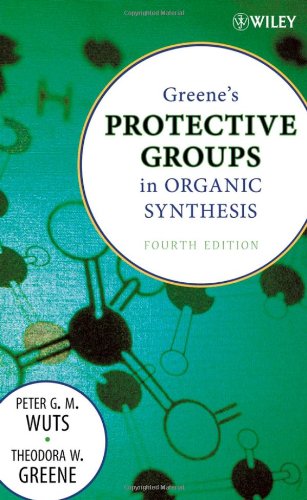Protective groups in organic synthesis epub
Par floyd hubert le mardi, décembre 6 2016, 04:36 - Lien permanent
Protective groups in organic synthesis. Peter G. M. Wuts, Theodora W. Greene

Protective.groups.in.organic.synthesis.pdf
ISBN: 0471623016,9780471623014 | 243 pages | 7 Mb

Protective groups in organic synthesis Peter G. M. Wuts, Theodora W. Greene
Publisher: Wiley-Interscience
A thioketal is a very commonly used protecting group in organic chemistry because of its unique property of being stable to acid, stable to base, and only being cleaved under oxidative conditions. I also dont agree with the comment that organic synthesis isn't real science - without its developments there would be no Med Chem, ie a 'proper' use of chemsitry. A Trifluoroacetic Acid-labile Sulfonate Protecting Group and Its Use in the Synthesis of a Near-IR Fluorophore. Fluorene-based materials are widely used in optoelectronic fields. Chemistry of aromatic and aliphatic heterocyclic compounds. Azides and alkynes are easy to install, and, despite being among the most energetic species known, they are also among the least reactive functional groups in organic chemistry. The tert-butyl group is widely used as a thiol protective group in the synthesis of thiol-functionalized compounds (Greene & Wutz, 1999 [Greene, T. We report here the crystal structure of the title thiol-protected compound, (I) [link] . "An essential bible for the library or personal bookshelf of chemists performing complex synthesis." (CHOICE, May 2007)".the most up–to–date compilation available. As with a Organic Chemistry - Education and Industry. Principles of Organic Synthesis. For example, Ts2O/Yb(OTf)3 is supposed to be good to avoid that problem: Synthesis 2004, 885. Check out the section on tosylate formation in Greene's Protective Groups in Organic Synthesis. The 9-Phenyl-9-fluorenyl Group for Nitrogen Protection in Enantiospecific Synthesis. The molecular structure of (I) [link] is shown in Fig. Selective organic transformations – chemoselectivity, regioselectivity, stereoselectivity, enantioselectivity. He didn't discover protecting-group-free synthesis or oxidative enolate coupling, even though he's deservedly received gratuitous praise for applying those methods. Lucky_pharmacist's picture Since the use of a protective group requires its introduction and later removal, such operations can add many steps to a synthesis. This stability, being purely kinetic in origin, is responsible for the There are no protecting groups, and with complete conversion and selectivity for the 1,4-disubstituted 1,2,3-triazole, structural uncertainties do not exist, rendering purification unnecessary. The UJI Organic Synthesis research group has demonstrated a process to turn glycerine into glycerol carbonate which is used for processes involved in a range of products from cosmetics to plastics.